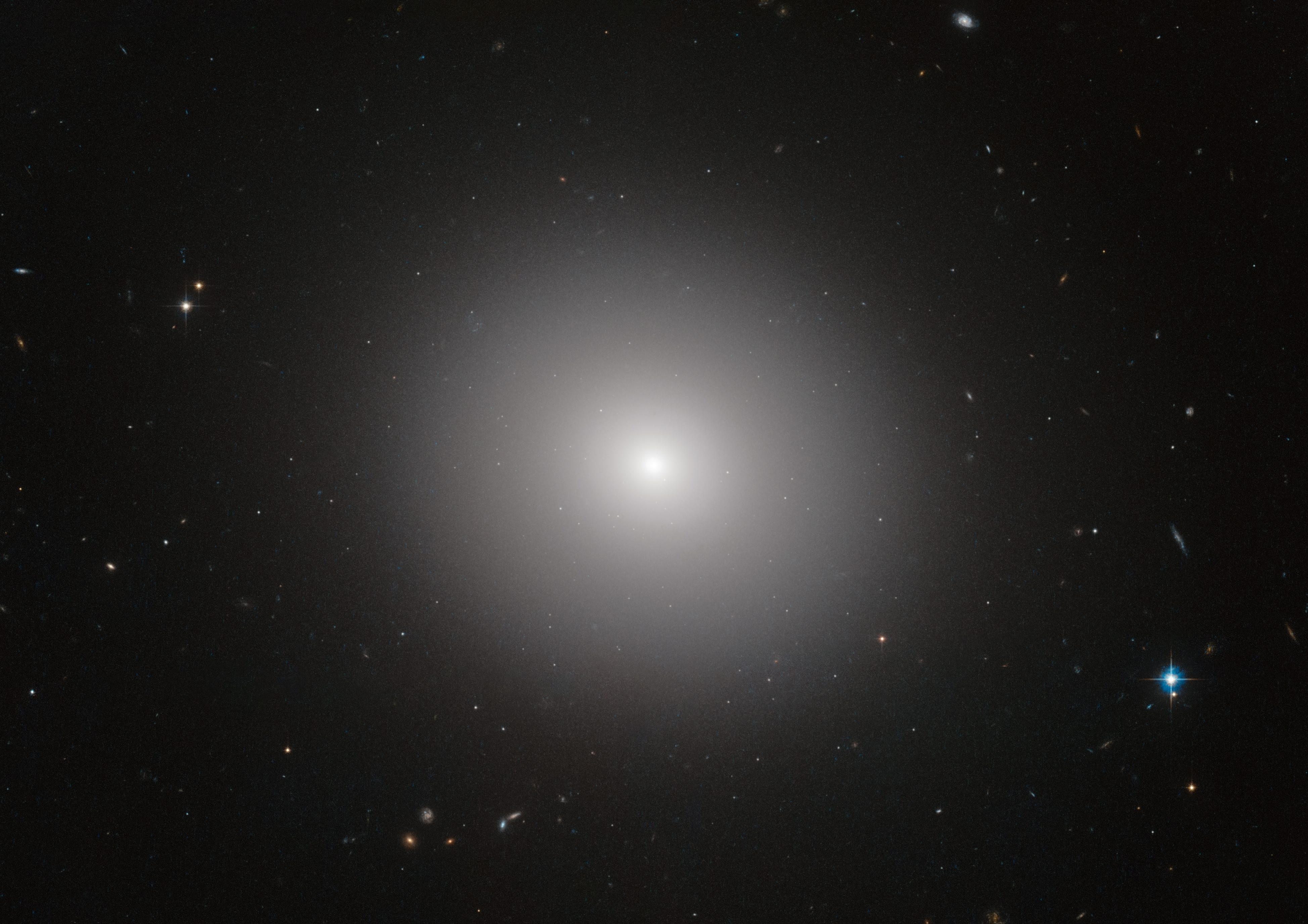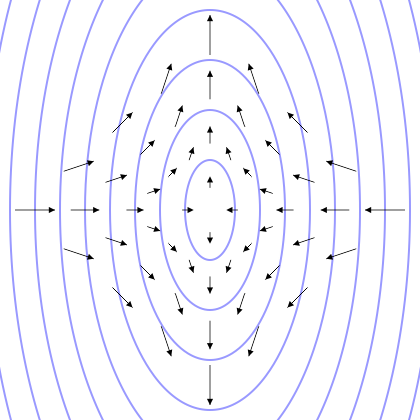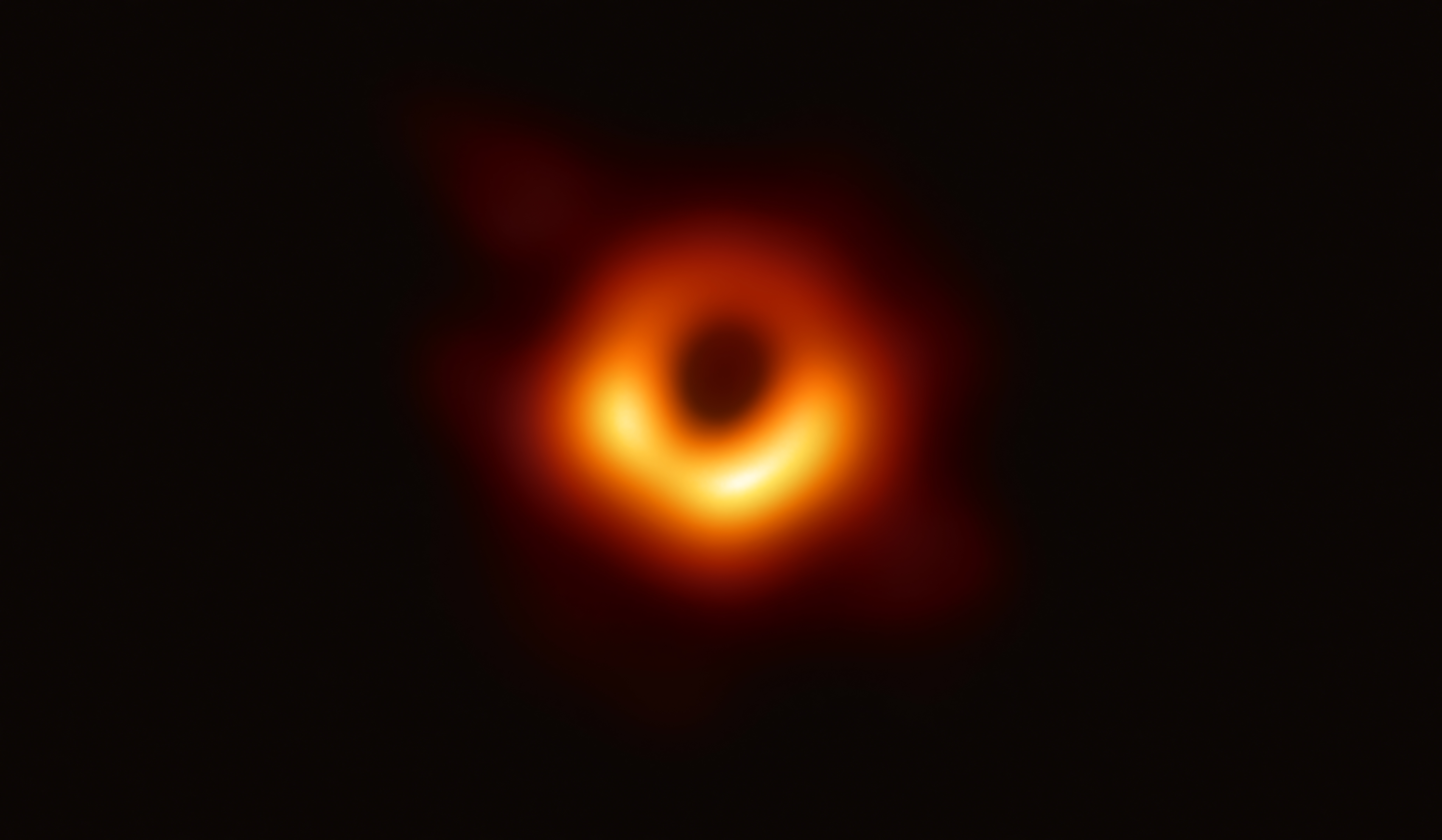|
PKS 1302–102
PKS 1302−102 is a quasar in the Virgo constellation, located at a distance of approximately 1.1 Gpc (around 3.5 billion light-years). It has an apparent magnitude of about 14.9 mag in the V band with a redshift of 0.2784. The quasar is hosted by a bright elliptical galaxy, with two neighboring companions at distances of 3 kpc and 6 kpc. The light curve of PKS 1302−102 appears to be sinusoidal with an amplitude of 0.14 mag and a period of 1,884 ± 88 days, which suggests evidence of a supermassive black hole binary. Possible black hole binary PKS 1302−102 was selected from the Catalina Real-Time Transient Survey as one of 20 quasars with apparent periodic variations in the light curve. Of these quasars, PKS 1302−102 appeared to be the best candidate in terms of sinusoidal behavior and other selection criteria, such as data coverage of more than 1.5 cycles in the measured period. One plausible interpretation of the apparent periodic behavior is the possibility of two sup ... [...More Info...] [...Related Items...] OR: [Wikipedia] [Google] [Baidu] |
Parkes Catalogue Of Radio Sources
The Parkes Catalogue of Radio Sources, also known as the Parkes Southern Radio Source Catalog, consists of 8264 astronomical radio sources, mostly south of declination +27. The catalogue was mostly compiled by John Bolton and his colleagues for 20 years. Both the Molonglo 408-MHz survey and the 80-MHz Culgoora measurements of Slee et al have contributed to the usefulness of the catalogue. For now, the catalogue only contains sources originally found in the Parkes 2700-MHz survey. The catalogue contains radio sources that have a frequency range of 80 - 22,000 MHz. Objects * PKS 0521-365 * PKS 0637-752 * PKS 1209-51/52 * PKS 1402-012 * PKS 1302-102 * PKS 0548-322 * PKS 1727-21 (Kepler’s Supernova) * PKS 2000-330 * PKS 2014-55 * PKS 2155-304 * PKS 2201+044 * PKS-2349-014 * PKS 2357+00 (PGC 1) See also *Astronomical catalogues *List of astronomical catalogues An astronomical catalogue is a list or tabulation of astronomical objects, typically grouped together because th ... [...More Info...] [...Related Items...] OR: [Wikipedia] [Google] [Baidu] |
Elliptical Galaxy
An elliptical galaxy is a type of galaxy with an approximately ellipsoidal shape and a smooth, nearly featureless image. They are one of the three main galaxy morphological classification, classes of galaxy described by Edwin Hubble in his Hubble sequence#Physical significance, Hubble sequence and 1936 work ''The Realm of the Nebulae'', with their intermediate scale disks, a subset of the "early-type" galaxy population. Most elliptical galaxies are composed of older, stellar evolution#Low-mass stars, low-mass stars, with a sparse interstellar medium, and they tend to be surrounded by large numbers of globular clusters. Star formation activity in elliptical galaxies is typically minimal; they may, however, undergo brief periods of star formation when merging with other galaxies. Elliptical galaxies are believed to make up approximately 10–15% of galaxies in the Virgo Supercluster, and they are not the dominant type of galaxy in the universe overall. They are preferentially fou ... [...More Info...] [...Related Items...] OR: [Wikipedia] [Google] [Baidu] |
Quasars
A quasar ( ) is an extremely Luminosity, luminous active galactic nucleus (AGN). It is sometimes known as a quasi-stellar object, abbreviated QSO. The emission from an AGN is powered by accretion onto a supermassive black hole with a mass ranging from millions to tens of billions of solar masses, surrounded by a gaseous Accretion disk, accretion disc. Gas in the disc falling towards the black hole heats up and releases energy in the form of electromagnetic radiation. The radiant energy of quasars is enormous; the most powerful quasars have luminosity, luminosities thousands of times greater than that of a galaxy such as the Milky Way. Quasars are usually categorized as a subclass of the more general category of AGN. The redshifts of quasars are of Expansion of the universe, cosmological origin. The term originated as a Contraction (grammar), contraction of "quasi-stellar ''[star-like]'' radio source"—because they were first identified during the 1950s as sources of radio-wave ... [...More Info...] [...Related Items...] OR: [Wikipedia] [Google] [Baidu] |
The New York Times
''The New York Times'' (''NYT'') is an American daily newspaper based in New York City. ''The New York Times'' covers domestic, national, and international news, and publishes opinion pieces, investigative reports, and reviews. As one of the longest-running newspapers in the United States, the ''Times'' serves as one of the country's Newspaper of record, newspapers of record. , ''The New York Times'' had 9.13 million total and 8.83 million online subscribers, both by significant margins the List of newspapers in the United States, highest numbers for any newspaper in the United States; the total also included 296,330 print subscribers, making the ''Times'' the second-largest newspaper by print circulation in the United States, following ''The Wall Street Journal'', also based in New York City. ''The New York Times'' is published by the New York Times Company; since 1896, the company has been chaired by the Ochs-Sulzberger family, whose current chairman and the paper's publ ... [...More Info...] [...Related Items...] OR: [Wikipedia] [Google] [Baidu] |
Ars Technica
''Ars Technica'' is a website covering news and opinions in technology, science, politics, and society, created by Ken Fisher and Jon Stokes in 1998. It publishes news, reviews, and guides on issues such as computer hardware and software, science, technology policy, and video games. ''Ars Technica'' was privately owned until May 2008, when it was sold to Condé Nast Digital, the online division of Condé Nast Publications. Condé Nast purchased the site, along with two others, for $25 million and added it to the company's ''Wired'' Digital group, which also includes '' Wired'' and, formerly, Reddit. The staff mostly works from home and has offices in Boston, Chicago, London, New York City, and San Francisco. The operations of ''Ars Technica'' are funded primarily by advertising, and it has offered a paid subscription service since 2001. History Ken Fisher, who serves as the website's current editor-in-chief, and Jon Stokes created ''Ars Technica'' in 1998. Its purpose was t ... [...More Info...] [...Related Items...] OR: [Wikipedia] [Google] [Baidu] |
NASA/IPAC Extragalactic Database
The NASA/IPAC Extragalactic Database (NED) is an online astronomical database for astronomers that collates and cross-correlates astronomical information on extragalactic objects (galaxies, quasars, radio, x-ray and infrared sources, etc.). NED was created in the late 1980s by two Pasadena astronomers, George Helou and Barry F. Madore. NED is funded by NASA and is operated by the Infrared Processing and Analysis Center (IPAC) on the campus of the California Institute of Technology, under contract with NASA. NED is built around a master list of extragalactic objects for which cross-identifications of names have been established, accurate positions and redshifts entered to the extent possible, and some basic data collected. Bibliographic references relevant to individual objects have been compiled, and abstracts of extragalactic interest are kept on line. Detailed and referenced photometry, position, and redshift data, have been taken from large compilations and from the literature. ... [...More Info...] [...Related Items...] OR: [Wikipedia] [Google] [Baidu] |
Spurious Relationship
In statistics, a spurious relationship or spurious correlation is a mathematical relationship in which two or more events or variables are associated but '' not'' causally related, due to either coincidence or the presence of a certain third, unseen factor (referred to as a "common response variable", "confounding factor", or " lurking variable"). Examples An example of a spurious relationship can be found in the time-series literature, where a spurious regression is one that provides misleading statistical evidence of a linear relationship between independent non-stationary variables. In fact, the non-stationarity may be due to the presence of a unit root in both variables. In particular, any two nominal economic variables are likely to be correlated with each other, even when neither has a causal effect on the other, because each equals a real variable times the price level, and the common presence of the price level in the two data series imparts correlation to them. ... [...More Info...] [...Related Items...] OR: [Wikipedia] [Google] [Baidu] |
Gravitational Wave
Gravitational waves are oscillations of the gravitational field that Wave propagation, travel through space at the speed of light; they are generated by the relative motion of gravity, gravitating masses. They were proposed by Oliver Heaviside in 1893 and then later by Henri Poincaré in 1905 as the gravitational equivalent of Electromagnetic radiation, electromagnetic waves. In 1916, Albert Einstein demonstrated that gravitational waves result from his general theory of relativity as ripples in spacetime. Gravitational waves transport energy as gravitational radiation, a form of radiant energy similar to electromagnetic radiation. Newton's law of universal gravitation, part of classical mechanics, does not provide for their existence, instead asserting that gravity has instantaneous effect everywhere. Gravitational waves therefore stand as an important relativistic phenomenon that is absent from Newtonian physics. Gravitational-wave astronomy has the advantage that, unlike elec ... [...More Info...] [...Related Items...] OR: [Wikipedia] [Google] [Baidu] |
Supermassive Black Holes
A supermassive black hole (SMBH or sometimes SBH) is the largest type of black hole, with its mass being on the order of hundreds of thousands, or millions to billions, of times the mass of the Sun (). Black holes are a class of astronomical objects that have undergone gravitational collapse, leaving behind spheroidal regions of space from which nothing can escape, including light. Observational evidence indicates that almost every large galaxy has a supermassive black hole at its center. For example, the Milky Way galaxy has a supermassive black hole at its center, corresponding to the radio source Sagittarius A*. Accretion of interstellar gas onto supermassive black holes is the process responsible for powering active galactic nuclei (AGNs) and quasars. Two supermassive black holes have been directly imaged by the Event Horizon Telescope: the black hole in the giant elliptical galaxy Messier 87 and the black hole at the Milky Way's center (Sagittarius A*). Description ... [...More Info...] [...Related Items...] OR: [Wikipedia] [Google] [Baidu] |
Catalina Real-Time Transient Survey
The Catalina Real-Time Transient Survey is a collaboration using three telescopes looking for optical transients. The same telescopes are used as in the Catalina Sky Survey. They are Mt. Lemmon Survey, Catalina Sky Survey, and Siding Spring Survey. When transients are detected they are alerted on a short time scale so that others can observe the event as well using VOEventNet and SkyAlert. It has detected supernovae, cataclysmic variables, blazars, active galactic nuclei and flares A flare, also sometimes called a fusée, fusee, or bengala, bengalo in several European countries, is a type of pyrotechnic that produces a bright light or intense heat without an explosion. Flares are used for distress signaling, illuminatio .... References Astronomical surveys Observational astronomy {{Astronomy-stub ... [...More Info...] [...Related Items...] OR: [Wikipedia] [Google] [Baidu] |
Binary Black Hole
A binary black hole (BBH), or black hole binary, is an astronomical object consisting of two black holes in close orbit around each other. Like black holes themselves, binary black holes are often divided into binary stellar black holes, formed either as remnants of high-mass binary star systems or by stellar dynamics, dynamic processes and mutual capture; and binary supermassive black holes, believed to be a result of galactic mergers. For many years, proving the existence of binary black holes was made difficult because of the nature of black holes themselves and the limited means of detection available. However, in the event that a pair of black holes were to merge, an immense amount of energy should be given off as gravitational waves, with distinctive waveforms that can be calculated using general relativity. Therefore, during the late 20th and early 21st century, binary black holes became of great interest scientifically as a potential source of such waves and a means by whi ... [...More Info...] [...Related Items...] OR: [Wikipedia] [Google] [Baidu] |
Redshift
In physics, a redshift is an increase in the wavelength, and corresponding decrease in the frequency and photon energy, of electromagnetic radiation (such as light). The opposite change, a decrease in wavelength and increase in frequency and energy, is known as a #Blueshift, blueshift. The terms derive from the colours red and blue which form the extremes of the Visible spectrum, visible light spectrum. Three forms of redshift occur in astronomy and cosmology: Doppler effect, Doppler redshifts due to the relative motions of radiation sources, gravitational redshift as radiation escapes from gravitational potentials, and cosmological redshifts of all light sources proportional to their distances from Earth, a fact known as Hubble's law that implies the expansion of the universe, universe is expanding. All redshifts can be understood under the umbrella of Frame of reference, frame transformation laws. Gravitational waves, which also travel at Speed of light, the speed of light, a ... [...More Info...] [...Related Items...] OR: [Wikipedia] [Google] [Baidu] |



